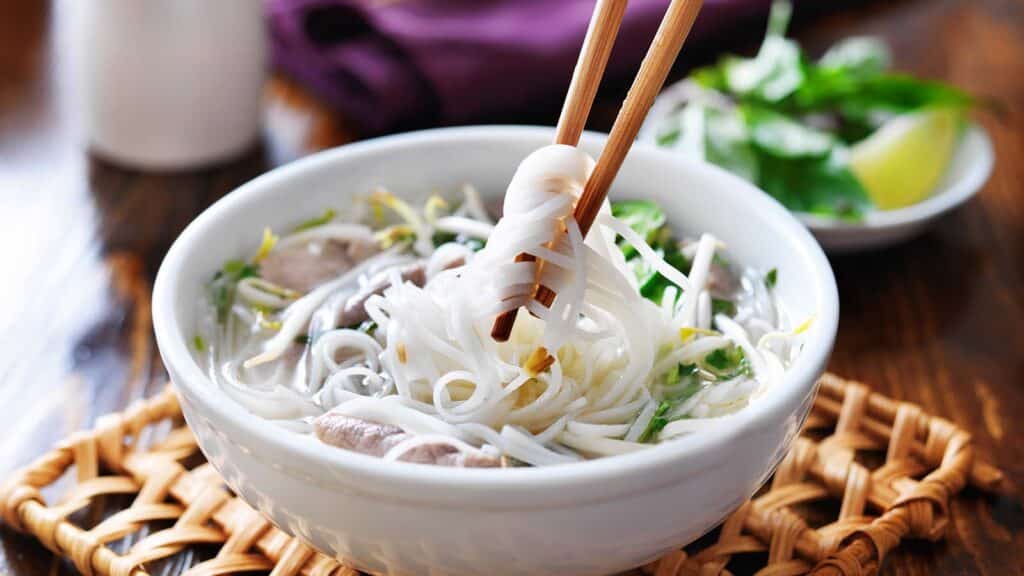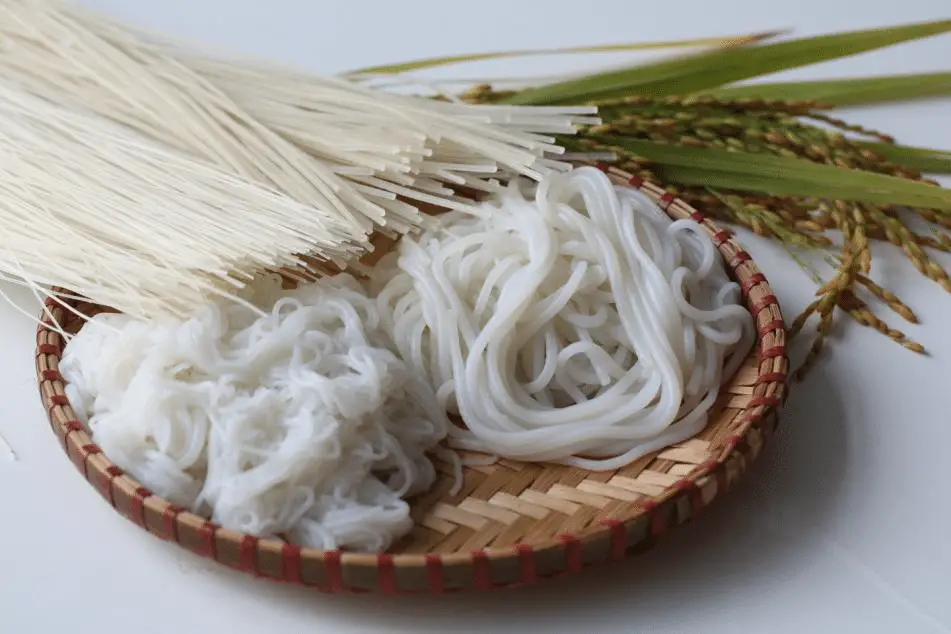Introduction
Are Rice Noodles Good For Weight Loss : Landscape of dietary choices for weight management, rice noodles have emerged as a noteworthy contender. These slender, translucent strands made from rice flour have gained popularity for their delicate texture and versatility in various cuisines, particularly in Asian dishes. To explore their nutritional profile, potential benefits, and how they can fit into a balanced weight loss plan.
Rice noodles, often featured in dishes like pad Thai, pho, and stir-fries, offer a unique alternative to traditional wheat-based pasta. They are gluten-free, making them suitable for those with gluten sensitivities or celiac disease. Moreover, rice noodles are known for being relatively low in fat and providing a quick source of energy due to their carbohydrate content.
However, like any food item, the benefits of rice noodles for weight loss depend on how they are prepared and incorporated into your diet. Their nutritional value and impact on weight management can vary significantly based on factors such as portion size, cooking methods, and the accompanying ingredients.

Can diabetics eat rice noodles?
Foods that contain unprocessed carbs can benefit people with diabetes, but eating large amounts in one sitting may raise blood sugar levels. People should spread their intake throughout the day.
Portion Control: Be mindful of your serving size. It’s important to control the amount of rice noodles you consume in one meal. Smaller portions can help prevent spikes in blood sugar levels.
Pair with Protein and Fiber: To help stabilize blood sugar levels, pair rice noodles with protein sources like lean chicken, tofu, or shrimp and incorporate plenty of fiber-rich vegetables. This combination can slow down the absorption of carbohydrates and reduce the impact on blood sugar.
Monitor Blood Sugar: Keep track of your blood sugar levels after consuming rice noodles to understand how they specifically affect you. Everyone’s response to carbohydrates can vary, so monitoring is essential.
Timing Matters: Spreading carbohydrate intake throughout the day can help maintain steady blood sugar levels. Consider eating rice noodles as part of a balanced meal and avoid consuming a large amount of carbohydrates all at once.
Choose Whole Grain Alternatives: Some varieties of rice noodles are made from brown rice, which contains more fiber and nutrients compared to white rice noodles. Opting for whole grain versions can be a healthier choice for people with diabetes.
Homemade Sauces: When preparing rice noodles, be cautious about store-bought sauces, which may contain added sugars. Making homemade sauces with minimal sugar or using low-sugar alternatives can be a better option.
Consult a Dietitian: For personalized guidance on incorporating rice noodles into a diabetes-friendly diet, consider consulting a registered dietitian or healthcare professional who can help you create a meal plan tailored to your needs and monitor your blood sugar responses.
Rice noodles can be included in a diabetic diet, but it’s crucial to be mindful of portion sizes, pair them with protein and fiber, and monitor blood sugar levels to make informed dietary choices. Consulting with a healthcare professional or dietitian can provide you with a more specific and personalized plan for managing your diabetes through diet.
Do rice noodles spike blood sugar?
Rice noodles, made from refined rice flour, have a high glycemic index. On average, a 1-cup serving of cooked rice noodles contains approximately 40-45 grams of carbohydrates. This means they are rapidly digested and can cause a significant increase in blood sugar levels.
To manage blood sugar levels when consuming rice noodles, individuals with diabetes or those concerned about blood sugar spikes should
Watch Portion Sizes: Controlling the portion size is essential. Smaller portions of rice noodles can help limit the impact on blood sugar.
Combine with Protein and Fiber: Pairing rice noodles with sources of protein (like tofu, lean meats, or beans) and fiber-rich vegetables can slow down the absorption of carbohydrates and help stabilize blood sugar.
Monitor Blood Sugar: Regularly monitoring blood sugar levels after consuming rice noodles can help you understand how your body responds to them and make necessary adjustments to your diet.
Choose Whole Grain Varieties: Opt for whole grain rice noodles if available, as they contain more fiber and nutrients compared to refined versions, which can lead to a slower rise in blood sugar.
Homemade Sauces: Be cautious about the sauces used with rice noodles, as some commercial sauces can contain added sugars. Preparing homemade sauces with minimal sugar or using low-sugar alternatives can help control blood sugar levels.
Spread Carbohydrate Intake: Distributing carbohydrate intake throughout the day, rather than consuming a large amount of carbohydrates in one sitting, can help maintain steady blood sugar levels.
Which noodles are best for weight loss?
Shirataki noodles are a unique food that’s very filling yet low in calories. These noodles are high in glucomannan, a type of fiber that has impressive health benefits. In fact, glucomannan has been shown to cause weight loss in numerous studies
Shirataki noodles are indeed an excellent option for those looking to manage their weight or reduce calorie intake while still enjoying noodle-based dishes. These noodles are unique in that they are very filling but extremely low in calories.
Low in Calories: Shirataki noodles are primarily composed of water and glucomannan, a type of soluble fiber. This means they are virtually calorie-free. A typical serving of shirataki noodles contains only a few calories, making them an excellent choice for reducing overall calorie intake in your meals.
High in Glucomannan: Glucomannan is a water-soluble dietary fiber known for its ability to expand in your stomach, creating a feeling of fullness and satiety. This can help control appetite and reduce overall food consumption, contributing to weight loss efforts.
Low in Carbohydrates: Shirataki noodles are very low in digestible carbohydrates, which can help stabilize blood sugar levels and prevent spikes that might trigger hunger and cravings.
While shirataki noodles offer unique benefits for weight management, they have a distinct texture and flavor, which may take some getting used to if you’re accustomed to traditional wheat-based noodles. Experimenting with different recipes and cooking techniques can help make the transition smoother.
Incorporating shirataki noodles into a well-balanced, calorie-controlled diet can be an effective strategy for weight loss. However, as with any dietary change, it’s advisable to consult with a healthcare provider or registered dietitian to ensure that your overall nutrition plan aligns with your specific weight loss goals and dietary preferences.
Which type of noodles are the healthiest?
Try one of these healthy noodle options to add more variety and nutrients to your next meal
Squash noodles. You can make your own noodles out of squash as a healthy, nutritious alternative to dried noodles from the store.
- Black bean noodles.
- Whole grain noodles.
- Quinoa noodles.
- Buckwheat noodles.
Among the options you’ve listed, whole grain noodles and quinoa noodles are generally considered some of the healthiest choices due to their nutritional profiles and benefits.
Whole Grain Noodles: Whole grain noodles are made from whole wheat flour, which retains the bran and germ of the wheat kernel. This means they are higher in fiber, vitamins, minerals, and phytonutrients compared to refined wheat noodles. The fiber content helps promote satiety and may assist in better blood sugar control.
Quinoa Noodles: Quinoa noodles are made from quinoa flour, a gluten-free whole grain known for its complete protein profile and various nutrients. They offer a good balance of carbohydrates, fiber, and protein. Quinoa is also rich in essential amino acids, making it a nutritious choice.
Is it OK to eat rice noodles everyday?
Do rice noodles have any downsides? Rice noodles are perfectly healthy and make a great addition to your diet. Still, they’re lower in fiber than other noodles, such as whole wheat noodles or spaghetti squash noodles.
Eating rice noodles every day is generally okay as part of a balanced diet, but it’s essential to consider your overall nutritional intake and dietary variety. While rice noodles can be a part of a healthy meal plan, there are a few factors to keep in mind:
Lower in Fiber: As you mentioned, rice noodles are lower in fiber compared to other noodle options like whole wheat noodles or spaghetti squash noodles. Dietary fiber is important for digestive health, satiety, and maintaining stable blood sugar levels. To compensate for the lower fiber content in rice noodles, consider pairing them with fiber-rich vegetables or incorporating other fiber sources into your daily meals.
Calorie Consideration: Rice noodles are relatively calorie-dense due to their carbohydrate content. If you’re aiming for weight management, it’s crucial to control portion sizes and balance them with protein and vegetables to create a well-rounded, satisfying meal without excessive calorie intake.
Nutritional Variety: Eating the same type of noodle every day may limit the variety of nutrients in your diet. Different types of noodles offer varying nutritional benefits. To ensure a broader spectrum of nutrients, consider rotating between rice noodles and other whole grain or vegetable-based noodles like whole wheat, quinoa, or zucchini noodles.
Sauces and Ingredients: Pay attention to the sauces and ingredients used with rice noodles. Some sauces may contain added sugars or unhealthy fats, which can affect the overall nutritional quality of your meal. Preparing homemade, healthier sauces or dressings can help control the nutritional profile of your dish.
Individual Tolerance: Individual responses to foods can vary. Some people may find that consuming rice noodles regularly suits their dietary preferences and digestion, while others may prefer more variety.
To include rice noodles in your diet, but it’s essential to do so in moderation and as part of a diverse and balanced meal plan. Be mindful of portion sizes, incorporate fiber-rich foods, and pay attention to the overall nutritional quality of your meals. By doing so, you can enjoy rice noodles while ensuring your diet remains well-rounded and nutritionally balanced.
Are there any benefits to rice noodles?
Rice noodles are also rich in selenium, an antioxidant that helps to protect your body from the risk of cancer, heart disease and many other serious illnesses. Finally, there is phosphorus. This helps with the storage and efficient use of energy and is important for healthy kidney function.
Rice noodles offer several benefits, and you’ve highlighted some of them. Here are the key advantages of consuming rice noodles.
Gluten-Free: Rice noodles are naturally gluten-free, making them an excellent choice for individuals with gluten sensitivities, celiac disease, or those following a gluten-free diet.
Low in Fat: Rice noodles are typically low in fat, which can be beneficial for those aiming to reduce their overall fat intake.
Source of Carbohydrates: Rice noodles provide a source of carbohydrates, which are the body’s primary energy source. Carbohydrates are essential for fueling your daily activities and maintaining energy levels.
Selenium Content: As you mentioned, rice noodles contain selenium, an essential mineral and antioxidant. Selenium plays a crucial role in protecting the body from oxidative stress, which can contribute to various health conditions, including cancer and heart disease.
Phosphorus: Rice noodles also contain phosphorus, which is important for bone health, energy storage and utilization, and kidney function. Phosphorus is a key component of ATP, the molecule that stores and transfers energy within cells.
Versatility: Rice noodles are highly versatile and can be used in a wide range of dishes, from Asian stir-fries to soups to salads. Their neutral flavor allows them to absorb the flavors of sauces and ingredients they are cooked with, making them a versatile addition to various cuisines.
Easy Digestion: For many people, rice noodles are easy to digest, making them a suitable choice for individuals with digestive sensitivities.
Are rice noodles healthy than pasta?
Yeah, They’re Gluten-Free, But Are Rice Noodles Healthy?
Pasta and rice noodles are just about tied when it comes to calories, fat and fiber, as well as on the carb front (if you’re on a low-carb diet like keto, stick to zoodles). Regular pasta has about 2 grams of sugar per serving while rice noodles are virtually sugar-free. Both are also free of cholesterol.
Comparing the healthiness of rice noodles and pasta depends on various factors, including your dietary preferences and nutritional goals. Here are some key points to consider
Gluten-Free: Rice noodles are gluten-free, which makes them a suitable choice for individuals with gluten sensitivities or celiac disease. Traditional wheat-based pasta contains gluten, so for those who need or prefer to avoid gluten, rice noodles are a healthier option.
Calories: Both rice noodles and pasta are relatively similar in terms of calories. The calorie content primarily depends on the serving size and the sauces or toppings used. Portion control is key for weight management with both types of noodles.
Fat Content: As mentioned, both rice noodles and pasta are low in fat. The fat content in your dish will depend more on the sauces and ingredients you use.
Fiber: Whole wheat pasta has more fiber than rice noodles since it retains the bran and germ of the wheat kernel. Fiber is essential for digestive health, satiety, and blood sugar control. If you’re looking to increase your fiber intake, whole wheat pasta or pasta made from legume flour can be healthier choices.
Sugar and Cholesterol: Both rice noodles and pasta are low in sugar and free of cholesterol. However, it’s crucial to be mindful of the sauces and condiments you use with them, as some can add sugar and unhealthy fats to your meal.
Nutrient Profile: Traditional pasta made from wheat flour contains more nutrients like B vitamins and minerals compared to rice noodles. If you’re looking for a more nutrient-dense option, whole wheat pasta might be preferable.
Whether rice noodles are healthier than pasta depends on your specific dietary needs and goals. Rice noodles are a good choice for those who require a gluten-free diet, while traditional pasta provides more nutrients due to its wheat flour base. To make your noodle-based dishes healthier, focus on portion control, choose whole grain pasta when possible, and pair noodles with protein sources and plenty of vegetables. The overall nutritional quality of your meal also depends on the sauces and ingredients you use, so make mindful choices to create balanced and nutritious dishes.
Can I eat noodles to lose belly fat?
Instant noodles are high in fat, carbs, and sodium but poor in protein, fiber, and other critical elements. They might not be a good option for people attempting to reduce weight because they can lead to weight gain and an increase in belly fat.
Eating noodles, especially instant noodles, as a primary strategy to lose belly fat is not advisable. Instant noodles are often high in unhealthy fats, refined carbohydrates, and sodium while lacking essential nutrients like protein and fiber.
High in Empty Calories: Instant noodles are calorie-dense but provide little nutritional value. They can contribute to weight gain when consumed in excess because they are often made from refined flour, which can lead to spikes in blood sugar levels and increased fat storage.
Low in Protein: Protein is crucial for weight loss and maintaining muscle mass. Instant noodles are typically low in protein, which is important for satiety and preventing muscle loss during a calorie-restricted diet.
Low in Fiber: Fiber is essential for digestive health and creating a feeling of fullness. Instant noodles are low in fiber, which means they may not keep you satisfied for long, leading to increased calorie consumption later in the day.
High Sodium Content: Instant noodles are notorious for their high sodium content. Excessive sodium intake can lead to water retention and bloating, potentially making your belly appear larger.
Lack of Nutrients: Instant noodles lack essential vitamins and minerals that are important for overall health and well-being. Relying on them as a primary source of nutrition can lead to nutrient deficiencies.
If you’re looking to lose belly fat or manage your weight, it’s essential to focus on a balanced, whole-foods-based diet that includes a variety of nutrient-rich foods. Incorporate lean proteins, fruits, vegetables, whole grains, and healthy fats into your meals. Reduce your intake of processed and high-calorie, low-nutrient foods like instant noodles.

Conclusion
The answer, like with many foods, lies in moderation and mindful consumption. Rice noodles can certainly be a part of a weight loss plan when approached thoughtfully. They offer several advantages, such as being gluten-free and a lower-fat alternative to traditional pasta, making them a viable option for those seeking to shed pounds while accommodating dietary restrictions.
However, it’s crucial to remember that the key to successful weight loss is not solely about one specific food but rather a holistic approach to your entire diet and lifestyle. Portion control is vital when incorporating rice noodles into your meals, as they can be calorie-dense if consumed excessively. Moreover, the choice of sauces and ingredients that accompany the noodles can greatly impact their nutritional value.
To optimize their role in a weight loss regimen, consider pairing rice noodles with lean proteins, plenty of vegetables, and lighter, homemade sauces or dressings. This way, you can create satisfying, nutrient-rich meals that support your weight loss goals while enjoying the delightful taste and versatility of rice noodles.
Ultimately, the effectiveness of rice noodles in your weight loss journey hinges on your ability to strike a balance, control portion sizes, and complement them with a well-rounded, wholesome diet and regular physical activity. As with any dietary choice, consult with a healthcare professional or registered dietitian to tailor your nutrition plan to your specific needs and goals.

